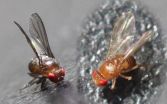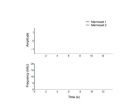(Press-News.org) MADISON, Wis. -- Koko the gorilla is best known for a lifelong study to teach her a silent form of communication, American Sign Language. But some of the simple sounds she has learned may change the perception that humans are the only primates with the capacity for speech.
In 2010, Marcus Perlman started research work at The Gorilla Foundation, where Koko has spent more than 40 years living immersed with humans -- interacting for many hours each day with psychologist Penny Patterson and biologist Ron Cohn.
"I went there with the idea of studying Koko's gestures, but as I got into watching videos of her, I saw her performing all these amazing vocal behaviors," says Perlman, now a postdoctoral researcher in the lab of University of Wisconsin-Madison psychology Professor Gary Lupyan.
The vocal and breathing behaviors Koko had developed were not necessarily supposed to be possible.
"Decades ago, in the 1930s and '40s, a couple of husband-and-wife teams of psychologists tried to raise chimpanzees as much as possible like human children and teach them to speak. Their efforts were deemed a total failure," Perlman says. "Since then, there is an idea that apes are not able to voluntarily control their vocalizations or even their breathing."
Instead, the thinking went, the calls apes make pop out almost reflexively in response to their environment -- the appearance of a dangerous snake, for example.
And the particular vocal repertoire of each ape species was thought to be fixed. They didn't really have the ability to learn new vocal and breathing-related behaviors.
These limits fit a theory on the evolution of language, that the human ability to speak is entirely unique among the nonhuman primate species still around today.
"This idea says there's nothing that apes can do that is remotely similar to speech," Perlman says. "And, therefore, speech essentially evolved -- completely new -- along the human line since our last common ancestor with chimpanzees."
However, in a study published online in July in the journal Animal Cognition, Perlman and collaborator Nathaniel Clark of the University of California, Santa Cruz, sifted 71 hours of video of Koko interacting with Patterson and Cohn and others, and found repeated examples of Koko performing nine different, voluntary behaviors that required control over her vocalization and breathing. These were learned behaviors, not part of the typical gorilla repertoire.
Among other things, Perlman and Clark watched Koko blow a raspberry (or blow into her hand) when she wanted a treat, blow her nose into a tissue, play wind instruments, huff moisture onto a pair of glasses before wiping them with a cloth and mimic phone conversations by chattering wordlessly into a telephone cradled between her ear and the crook of an elbow.
"She doesn't produce a pretty, periodic sound when she performs these behaviors, like we do when we speak," Perlman says. "But she can control her larynx enough to produce a controlled grunting sound."
Koko can also cough on command -- not particularly groundbreaking human behavior, but impressive for a gorilla because it requires her to close off her larynx.
"The motivation for the behaviors varies," Perlman says. "She often looks like she plays her wind instruments for her own amusement, but she tends to do the cough at the request of Penny and Ron."
These behaviors are all learned, Perlman figures, and the result of living with humans since Koko was just six months old.
"Presumably, she is no more gifted than other gorillas," he says. "The difference is just her environmental circumstances. You obviously don't see things like this in wild populations."
This suggests that some of the evolutionary groundwork for the human ability to speak was in place at least by the time of our last common ancestor with gorillas, estimated to be around 10 million years ago.
"Koko bridges a gap," Perlman says. "She shows the potential under the right environmental conditions for apes to develop quite a bit of flexible control over their vocal tract. It's not as fine as human control, but it is certainly control."
Orangutans have also demonstrated some impressive vocal and breathing-related behavior, according to Perlman, indicating the whole great ape family may share the abilities Koko has learned to tap.
INFORMATION:
Chris Barncard, 608-890-0465, barncard@wisc.edu
MADISON, Wis. -- The crucial genetic mashup that spawned the yeast that brews the vast majority of beer occurred at least twice -- and both times without human help -- according to a University of Wisconsin-Madison study published Aug. 11 in the journal Molecular Biology and Evolution.
Lager yeast, a hybrid that thrives in cold temperatures, is used in lager beer production, which accounts for about 94 percent of the world's beer.
And while 15th century Bavarian monks invented lager beer, they probably did not deliberately cause the hybridizations detailed by a team ...
LOS ALAMOS, N.M., August 13, 2015--A team of researchers has discovered a Jupiter-like planet within a young system that could provide a new understanding of how planets formed around our sun.
The new planet, called 51 Eridani b, is the first exoplanet discovered by the Gemini Planet Imager (GPI), a new instrument operated by an international collaboration headed by Bruce Macintosh, a professor of physics in the Kavli Institute at Stanford University. It is a million times fainter than its star and shows the strongest methane signature ever detected on an alien planet, ...
WASHINGTON - Violent video game play is linked to increased aggression in players but insufficient evidence exists about whether the link extends to criminal violence or delinquency, according to a new American Psychological Association task force report.
"The research demonstrates a consistent relation between violent video game use and increases in aggressive behavior, aggressive cognitions and aggressive affect, and decreases in prosocial behavior, empathy and sensitivity to aggression," says the report of the APA Task Force on Violent Media. The task force's review ...
Recent Massachusetts General Hospital (MGH) investigations into the neurobiology underlying the effects of general anesthesia have begun to reveal the ways different anesthetic agents alter specific aspects of the brain's electrical signals, reflected by EEG (electroencephalogram) signatures. While those studies have provided information that may lead to improved techniques for monitoring the consciousness of patients receiving general anesthesia, until now they have been conducted in relatively young adult patients. Now a series of papers from MGH researchers is detailing ...
You've heard that romance starts in the kitchen and not in the bedroom. Well, researchers at Drexel University finally have the science to support that saying - but not the way you might think.
In a new study published online in the journal Appetite, researchers found that women's brains respond more to romantic cues on a full stomach than an empty one. The study explored brain circuitry in hungry versus satiated states among women who were past-dieters and those who had never dieted.
The study's first author Alice Ely, PhD, completed the research while pursuing a ...
For the first time, Lawrence Livermore scientists as part of an international team, have discovered the most Jupiter-like planet ever seen in a young star system, lending clues to understanding how planets formed around our sun.
Using a new advanced adaptive optics (AO) device on the Gemini Planet Imager (GPI) on the Gemini South Telescope in Chile, the team took an image of the planet, which is about twice the size of Jupiter.
Called 51 Eridani b, the planet is the first in a wave of discoveries by a new generation of planet-hunting instruments, and could help scientists ...
Scientists at The Field Museum have identified a new species of pre-mammal in what is now Zambia. Thanks to a unique groove on the animal's upper jaw, it was dubbed Ichibengops (Itchy-BEN-gops), which combines the local Bemba word for scar (ichibenga), and the common Greek suffix for face (ops). Put simply: Scarface.
Believed to be roughly the size of a dachshund, Ichibengops lived around 255 million years ago, and was a member of Therocephalia, a group of ancient mammal relatives that survived the largest mass extinction in history (the Permian-Triassic extinction). ...
Scientists have been fascinated by a series of unusual exploding stars -- outcasts beyond the typical cozy confines of their galaxies. A new analysis of 13 supernovae -- including archived data from NASA's Hubble Space Telescope -- is helping astronomers explain how some young stars exploded sooner than expected, hurling them to a lonely place far from their host galaxies.
It's a complicated mystery of double-star systems, merging galaxies, and twin black holes that began in 2000 when the first such supernova was discovered, according to study leader Ryan Foley, University ...
New research from North Carolina State University and Reed College shows that when fruit flies are attacked by parasites or bacteria they respond by producing offspring with greater genetic variability. This extra genetic variability may give the offspring an increased chance of survival when faced with the same pathogens. These findings demonstrate that parents may purposefully alter the genotypes of their offspring.
Fruit flies' reproductive cells are usually haploid, meaning that there is only one copy of each chromosome in the cell's nucleus instead of two. During ...
This news release is available in Japanese.
As nonhuman primates mature, their vocalizations are thought to be minimally or not at all influenced by caregivers - but a new study reveals that infant marmosets use cues from adults as they develop vocalizations. In a surprise twist then, humans may not be the only primates whose vocal development benefits from early communication. To monitor and measure the vocal development in marmosets, Daniel Takahashi et al. recorded vocalizations between the first day of birth and two months of age, using four well-established ...



